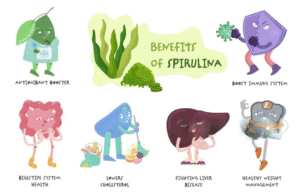Spirulina: The Blue-Green Superfood – Benefits, Research, and Applications

Spirulina: The Blue-Green Superfood – Benefits, Research, and Applications
In the quest for nutrient-dense superfoods that deliver exceptional health benefits, spirulina stands as one of the most remarkable discoveries. This microscopic blue-green algae has been consumed for centuries by different cultures, but only in recent decades has modern science begun to fully appreciate its extraordinary nutritional profile and therapeutic potential.
What Is Spirulina?
Spirulina is a type of cyanobacteria, a family of single-celled microbes that are often referred to as blue-green algae. It naturally grows in warm, alkaline lakes in subtropical and tropical regions. The two most common species used for human consumption are Arthrospira platensis and Arthrospira maxima.
This aquatic organism gets its name from its spiral shape, visible under a microscope. When harvested and dried, spirulina transforms into a dark green powder with a distinctive, somewhat fishy taste that can be incorporated into various foods and beverages or consumed as supplements.
Exceptional Nutritional Profile
What makes spirulina truly stand out is its remarkable density of nutrients within a small volume. It contains:
Protein Content
Spirulina comprises approximately 60-70% protein by weight—a higher percentage than most other plant foods. Moreover, it’s a complete protein source, containing all nine essential amino acids, though in varying proportions.
Vitamins and Minerals
This blue-green algae is particularly rich in:
- Vitamin B1 (thiamine)
- Vitamin B2 (riboflavin)
- Vitamin B3 (niacin)
- Copper
- Iron
- Magnesium
- Potassium
- Manganese
Phytonutrients
Spirulina contains numerous beneficial plant compounds:
- Phycocyanin: A pigment-protein complex that gives spirulina its unique blue-green color and possesses potent antioxidant and anti-inflammatory properties
- Chlorophyll: Known for its detoxifying capabilities
- Carotenoids: Including beta-carotene and zeaxanthin
- Gamma-linolenic acid (GLA): An essential fatty acid with anti-inflammatory effects
Health Benefits Supported by Research
The scientific community has conducted extensive research on spirulina, revealing numerous potential health benefits:
Antioxidant and Anti-inflammatory Effects
The phycocyanin in spirulina is a powerful antioxidant that helps combat oxidative stress and inflammation in the body. Studies suggest that regular consumption of spirulina may help reduce markers of oxidative damage and inflammation, which are underlying factors in many chronic diseases.
A 2018 systematic review published in the journal Nutrients found that spirulina supplementation significantly improved markers of oxidative stress in various populations, supporting its role as an antioxidant supplement.
Immune System Support
Research indicates that spirulina may enhance immune function by increasing the production of antibodies and cytokines—signaling proteins that regulate immunity. A study published in the Journal of Medicinal Food demonstrated that spirulina increased the production of interferon gamma, an important immune system mediator.
Additionally, spirulina has been shown to promote the activity of natural killer (NK) cells, which are crucial for immune surveillance and defense against pathogens and cancer cells.
Cardiovascular Health Benefits
Several clinical trials have investigated spirulina’s effects on cardiovascular risk factors. These studies have found that spirulina supplementation can:
- Reduce LDL (“bad”) cholesterol and triglyceride levels
- Increase HDL (“good”) cholesterol
- Lower blood pressure in some individuals with hypertension
- Improve endothelial function, enhancing blood vessel health
A meta-analysis published in the Clinical Nutrition journal confirmed that spirulina supplementation had favorable effects on blood lipid profiles, supporting its potential role in cardiovascular disease prevention.
Blood Sugar Regulation
For individuals concerned about blood glucose management, spirulina shows promising effects. Research suggests that compounds in spirulina may:
- Improve insulin sensitivity
- Reduce fasting blood glucose levels
- Decrease glycated hemoglobin (HbA1c) levels, an important marker of long-term glucose control
A randomized controlled trial published in Nutrients found that participants who consumed spirulina experienced significant improvements in blood glucose parameters compared to those taking a placebo.
Liver Protection
Spirulina has demonstrated hepatoprotective (liver-protecting) effects in various studies. Its high antioxidant content appears to help safeguard liver cells from damage caused by toxins and oxidative stress.
Research involving patients with non-alcoholic fatty liver disease found that spirulina supplementation improved liver enzyme levels and reduced liver fat accumulation, suggesting its potential as an adjunct therapy for this increasingly common condition.
Allergic Rhinitis Relief
For those suffering from seasonal allergies, spirulina may offer natural relief. A study published in the Journal of Medicinal Food found that participants taking spirulina experienced significant improvement in symptoms such as nasal discharge, sneezing, nasal congestion, and itching compared to those taking a placebo.
Exercise Performance and Recovery
Athletes and fitness enthusiasts may benefit from spirulina’s potential ergogenic effects. Research suggests that it may:
- Increase endurance performance
- Reduce exercise-induced oxidative damage
- Enhance muscle recovery after intense physical activity
- Improve fat oxidation during exercise
A study published in Medicine & Science in Sports & Exercise found that spirulina supplementation significantly improved time to exhaustion in moderately trained individuals.
Practical Applications and Consumption
Dietary Incorporation
There are numerous ways to incorporate spirulina into daily nutrition:
- Mixed into smoothies or protein shakes
- Sprinkled over salads or soups
- Added to energy balls or homemade granola bars
- Incorporated into pasta dough for a nutritional boost
- Blended into guacamole or hummus
- Added to fresh-pressed juices
Supplementation
For those who find the taste challenging, spirulina is available in convenient supplement forms:
- Tablets
- Capsules
- Powder (which can be encapsulated at home)
The recommended dosage typically ranges from 1-8 grams daily, with many studies showing benefits at 3-5 grams per day. As with any supplement, it’s advisable to start with a lower dose and gradually increase to assess tolerance.
Potential Considerations and Precautions
While spirulina is generally recognized as safe for most people, several considerations warrant attention:
- Quality matters: Due to its growth requirements, spirulina can potentially absorb heavy metals from its environment. Purchasing from reputable suppliers who conduct regular testing is essential.
- Autoimmune conditions: People with autoimmune conditions like multiple sclerosis, rheumatoid arthritis, or lupus should consult healthcare providers before supplementing, as spirulina’s immune-stimulating effects could potentially exacerbate symptoms.
- Medication interactions: Spirulina may interact with certain medications, particularly immunosuppressants and anticoagulants.
- Pregnancy and breastfeeding: Limited research exists on spirulina safety during pregnancy and lactation, so consultation with a healthcare provider is recommended.
- Phenylketonuria (PKU): Individuals with this condition should avoid spirulina due to its phenylalanine content.
Sustainability Aspects
Beyond its nutritional benefits, spirulina presents compelling sustainability advantages:
- Requires significantly less water than conventional protein sources
- Needs minimal land area for cultivation
- Can be grown using seawater in coastal regions, reducing freshwater demand
- Absorbs carbon dioxide during growth, potentially helping mitigate climate change
- Provides a complete nutrient source with minimal environmental impact
These characteristics have prompted the United Nations to identify spirulina as a potential solution to food security challenges, particularly in regions facing nutritional deficiencies and environmental constraints.
Future Research Directions
While existing research on spirulina is promising, several areas warrant further investigation:
- Optimal dosing regimens for specific health conditions
- Long-term safety and efficacy studies
- Potential applications in managing specific diseases
- Bioavailability enhancement techniques
- Genetic modifications to improve nutritional content and growth efficiency
Conclusion
Spirulina represents one of nature’s most nutritionally complete superfoods, offering an impressive array of health benefits supported by a growing body of scientific evidence. From its exceptional protein content and antioxidant properties to its potential role in managing chronic diseases, this blue-green algae deserves its reputation as a nutritional powerhouse.
As research continues to unveil spirulina’s therapeutic potential, incorporating this ancient food into modern diets appears increasingly justified—whether as a supplement to address specific health concerns or as a daily nutritional enhancement. With proper consideration of quality, dosage, and individual health circumstances, spirulina offers a sustainable and efficient way to boost nutrition and potentially improve various aspects of health and wellbeing.

